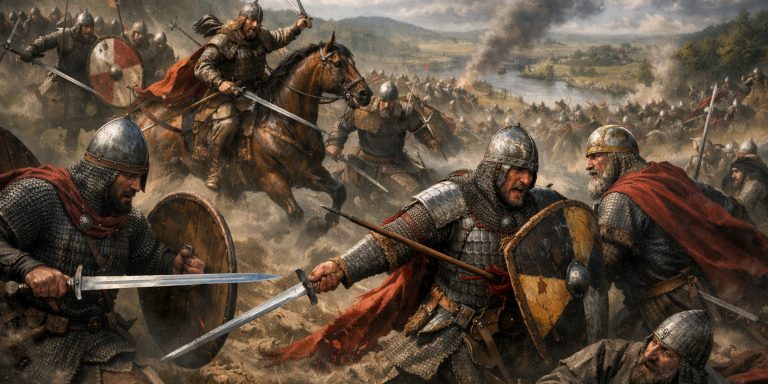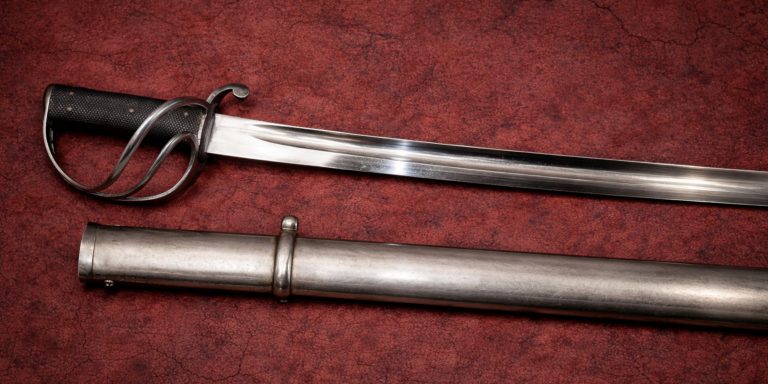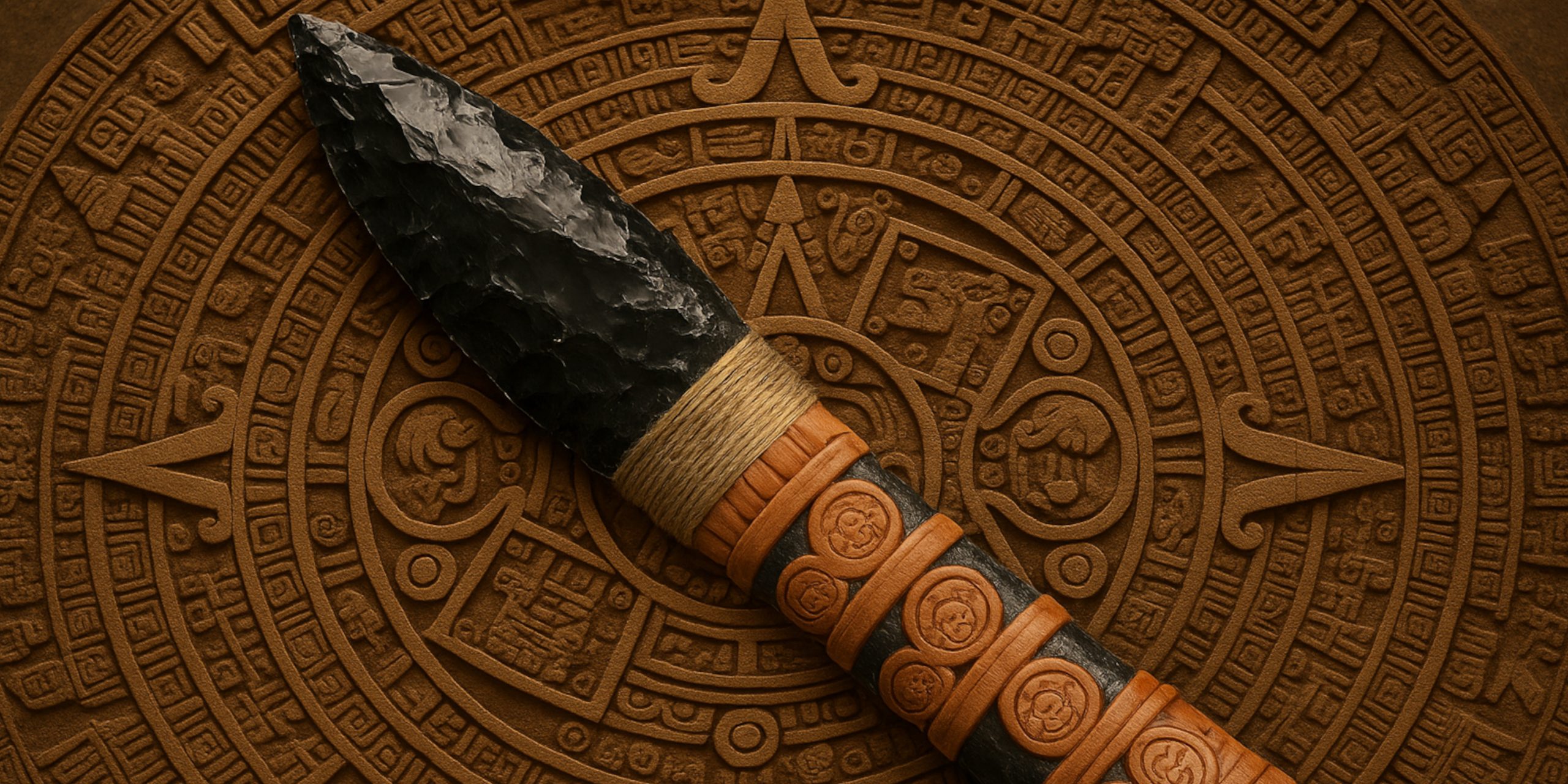
The Aztecs, or Mexica, built a highly organised and ritualistic military system that relied heavily on discipline, symbolism, and specialist weaponry. Unlike European armies, their warfare was often aimed at capturing enemies alive for sacrifice rather than outright killing. Their weapons were crafted from materials like hardwood, obsidian, flint, and bone, designed to be both brutal and precise. Among these, the macuahuitl stands out as the most iconic, but the full arsenal of Aztec warfare reveals much about their society, status hierarchy, and tactical mindset.
Aztec Weapons (by Type)

Macuahuitl (c. 1300s–1521)
The macuahuitl is often described as a wooden sword. It consisted of a flat, paddle-shaped hardwood body with sharp obsidian blades embedded into its edges using natural adhesive. Some accounts describe both one-handed and two-handed versions. Spanish chroniclers claimed it could decapitate a horse with a single blow. Despite its sword-like form, it functioned more like a hybrid between a club and a cleaver, capable of delivering deep lacerations or disabling strikes.
- Material: Oak or other hardwood, obsidian
- Length: 70–120 cm
- Used by: Elite warriors, including Jaguar and Eagle orders
Tepoztopilli (c. 1300s–1521)

A polearm with a leaf- or triangle-shaped head lined with obsidian blades. Unlike the macuahuitl, this weapon had reach and could be used to thrust or slash. It was ideal for close-rank formation fighting and was sometimes preferred by battlefield officers.
- Material: Wood shaft, obsidian blades
- Length: Often over 180 cm
- Used by: Front-line warriors and guards
Quauholōlli (c. 1200s–1521)
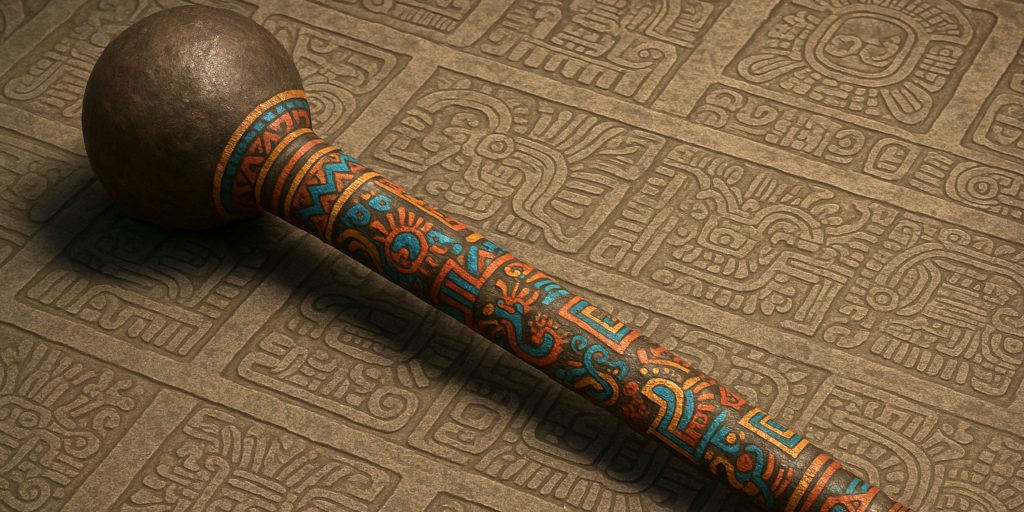
A mace-like club featuring a rounded head made of wood or stone. It lacked the cutting power of obsidian but was highly effective against shields and helmets. It was often a starter weapon for lower-ranked warriors.
- Material: Wood, with stone or hardwood ball
- Length: 50–80 cm
- Used by: Novice or young warriors
Tecpatl (c. pre-1200s–1521)
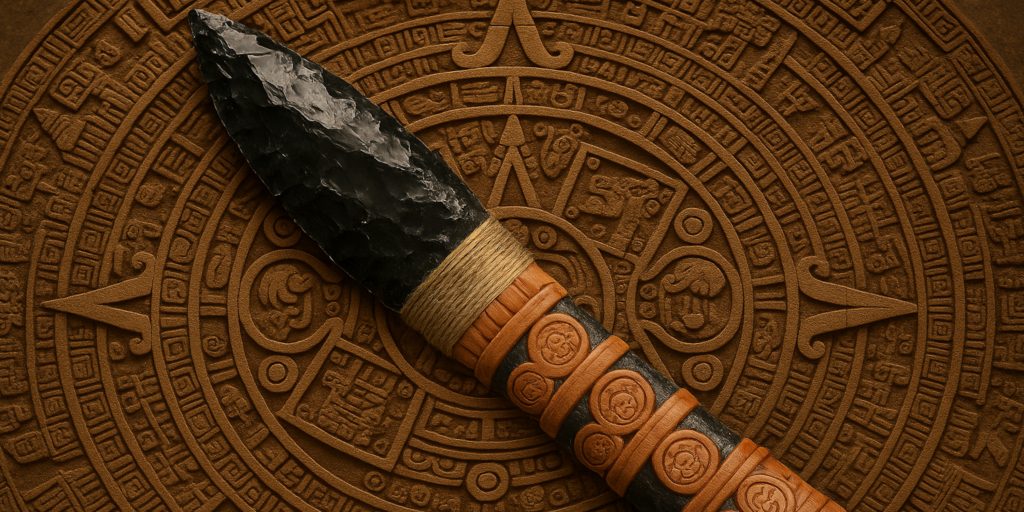
A ritual knife used in ceremonies and warfare. Tecpatl were typically short, double-edged blades made of flint or obsidian, used both for stabbing and for human sacrifice. They were often carried as secondary weapons.
- Material: Flint or obsidian
- Length: 20–30 cm
- Used by: Priests and elite warriors
Atlatl (Spear Thrower) (c. 1000s–1521)

This device acted as a lever to throw spears or darts with far more force than by hand. Darts fired from an atlatl could penetrate light armour and hit targets over 100 metres away. Atlatls were status symbols and were often engraved with imagery of gods or animals.
- Material: Wood, with leather or shell inlays
- Range: Up to 120 metres
- Used by: Jaguar warriors, nobles
Tlacochtli (Throwing Spears) (c. 1000s–1521)
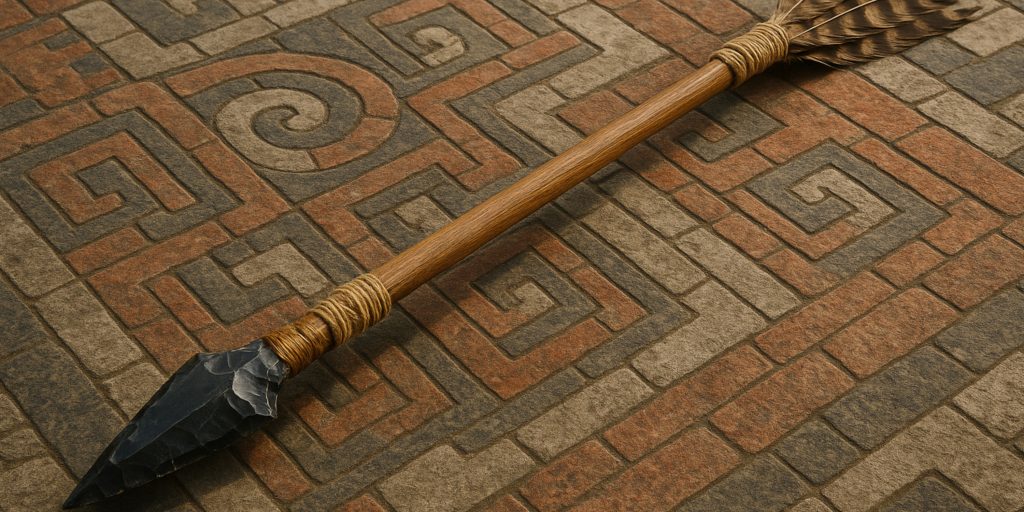
These were the darts or javelins launched using an atlatl. Their shafts were often decorated, and the tips could be made from obsidian, bone, or hardened wood.
- Material: Wood with obsidian or bone points
- Length: 1–1.5 metres
- Used by: All warrior classes, depending on access
Tlahuitolli (Bow) and Mitl (Arrows) (c. 1100s–1521)

The Aztec bow was about five feet long and made from flexible wood. Arrows were feathered and tipped with obsidian, flint, or bone. Though not as dominant as the atlatl, bows were used during sieges and in early phases of battles.
- Material: Wood, sinew, obsidian
- Range: 80–100 metres
- Used by: Ranged units and hunters
Tematlatl (Sling) (c. unknown–1521)
Slings were made from plant fibres and used to hurl stones, some of which were sharpened or fire-hardened. They required skill but were effective in softening enemy lines or harassing during sieges.
- Material: Woven agave fibres
- Range: Up to 150 metres
- Used by: Peasant levies and auxiliary troops
Chimalli (Shield) (c. 1300s–1521)
Used defensively, the chimalli was a round shield often decorated with feathers, animal skins, and precious stones. It was made from cane, wood, and leather, capable of deflecting arrows and light strikes.
- Material: Cane, wood, leather, feathers
- Diameter: 60–80 cm
- Used by: All warriors; designs reflected rank
Combat Style and Battlefield Role
Aztec warfare emphasised agility, formation control, and psychological intimidation. Warriors advanced in units according to their status: novices in front with blunt weapons, seasoned veterans behind with macuahuitl and atlatl, and elite orders operating as shock troops or flanking elements. The battlefield was often a theatre for demonstrating bravery, divine favour, and martial skill.
Capturing enemies alive was not just an ideal but a key objective. The design of many weapons, especially the macuahuitl and tepoztopilli, allowed for disabling blows rather than fatal ones, though lethal force was absolutely within reach.
Collector’s Guide to Aztec Weapons
Original Aztec weapons are exceedingly rare, largely due to the organic materials used and the destructive effects of the Spanish conquest. Most surviving examples are ceremonial or artistically reconstructed, and authentic battlefield pieces are virtually nonexistent in private hands.
However, interest in collecting Aztec weaponry—particularly replicas—has grown steadily among historians, reenactors, and cultural enthusiasts. Below is a guide for collectors navigating this space:
What Can Be Collected
- High‑quality replicas of the macuahuitl, often handcrafted with real obsidian, are available through specialist artisans or museum workshops.
- Decorative shields (chimalli) using traditional featherwork patterns can be found, though few replicate the original materials.
- Flint and obsidian knives (tecpatl) are commonly reproduced using ancient techniques, sometimes by modern-day Nahua craftsmen.
- Atlatl sets (spear throwers with darts) can be acquired from experimental archaeologists or primitive weapons specialists.
What to Look For
- Authenticity of materials: Real obsidian, carved hardwood, and period-accurate adhesives make a difference.
- Craft technique: Hand-inlaid obsidian and historically accurate shaping matter more than polish.
- Source credibility: Buy from museums, university-backed vendors, or indigenous creators when possible.
Where to Buy or View
- Museums:
- Museo Nacional de Antropología (Mexico City) – holds original artefacts and reconstructions.
- British Museum – some colonial-period examples and codices illustrating weapon use.
- American Museum of Natural History – holds replicas and carved temple panels.
- Artisan markets and online:
- Look for makers in central Mexico, particularly around Tepoztlán and Puebla.
- Online forums for historical weaponry sometimes feature custom-made replicas.
Auction Prices and Rarity
Due to export restrictions and the scarcity of surviving objects, genuine pre-Columbian Aztec weapons rarely appear at auction. Replicas, depending on craftsmanship and materials, can range from:
- £100–£500: Mid-range macuahuitl replicas with basic obsidian.
- £500–£2,000+: Museum-grade, artist-signed reproductions using authentic methods.
Buyers should be cautious of items marketed as “original” or “battle-used” without provenance, as many are later-period creations or misattributed.
The Seven Swords Takeaway
Though the Spanish conquest brought an end to Aztec independence, descriptions of their weaponry survive in codices and colonial records. Experimental archaeology has confirmed the cutting power of obsidian blades, and modern reconstructions of the macuahuitl have demonstrated that its legendary sharpness was not exaggerated.
Watch the documentary:


